Abstract
Some pharmacological properties of the GABAA receptor complex in the rat cuneate nucleus slice have been assessed from depolarization responses to the gamma-aminobutyric acid (GABA) analogue muscimol and antagonism of the responses by bicuculline and picrotoxin. Responses to muscimol were potentiated by the following drugs, in descending order of potency with regard to the concentrations required in the Krebs medium: (+/-)-5-(1,3-dimethylbutyl)-5-ethylbarbituric acid [+/-)-DMBB) = (+/-)-quinalbarbitone = (+/-)-pentobarbitone greater than (+/-)-methyl-phenobarbitone = (-)-methylphenobarbitone greater than butobarbitone = chlormethiazole greater than phenobarbitone greater than barbitone = (+)-methylphenobarbitone. Primidone and phenylethylmalonamide were inactive. Calculation of the concentrations likely to be present in membrane lipids for equal potentiations of muscimol revealed little difference between quinalbarbitone, pentobarbitone, phenobarbitone and barbitone. The effect of picrotoxin as a muscimol antagonist was selectively reduced only by DMBB, chlormethiazole, phenobarbitone and (-)-methylphenobarbitone in concentrations that caused only a modest potentiation of muscimol. It is suggested that a specific site of action in the GABAA receptor complex is involved in the reduction of picrotoxin effect and that this may be relevant to the anticonvulsant properties of chlormethiazole, phenobarbitone and (-)-methylphenobarbitone. The potentiation of muscimol by chlormethiazole and the barbiturates in general involves a distinctly different site that is less selective and this may underlie the hypnotic properties of these drugs.
Full text
PDF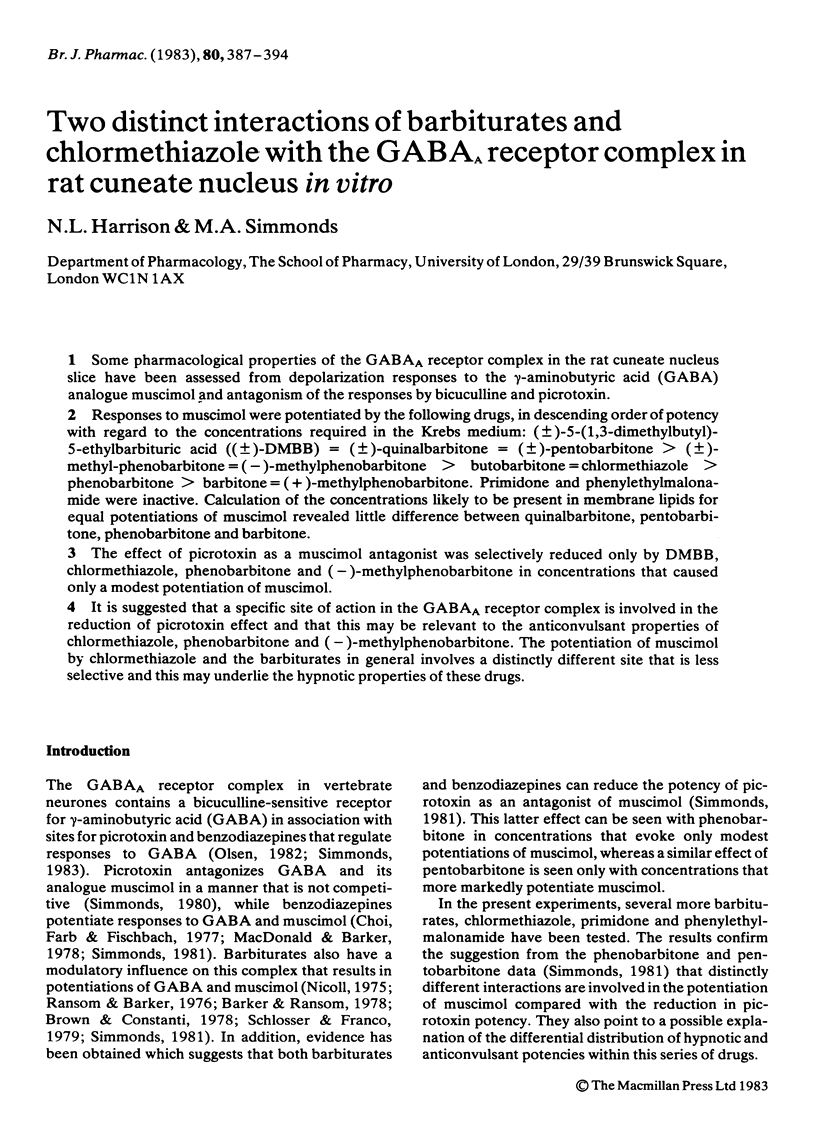
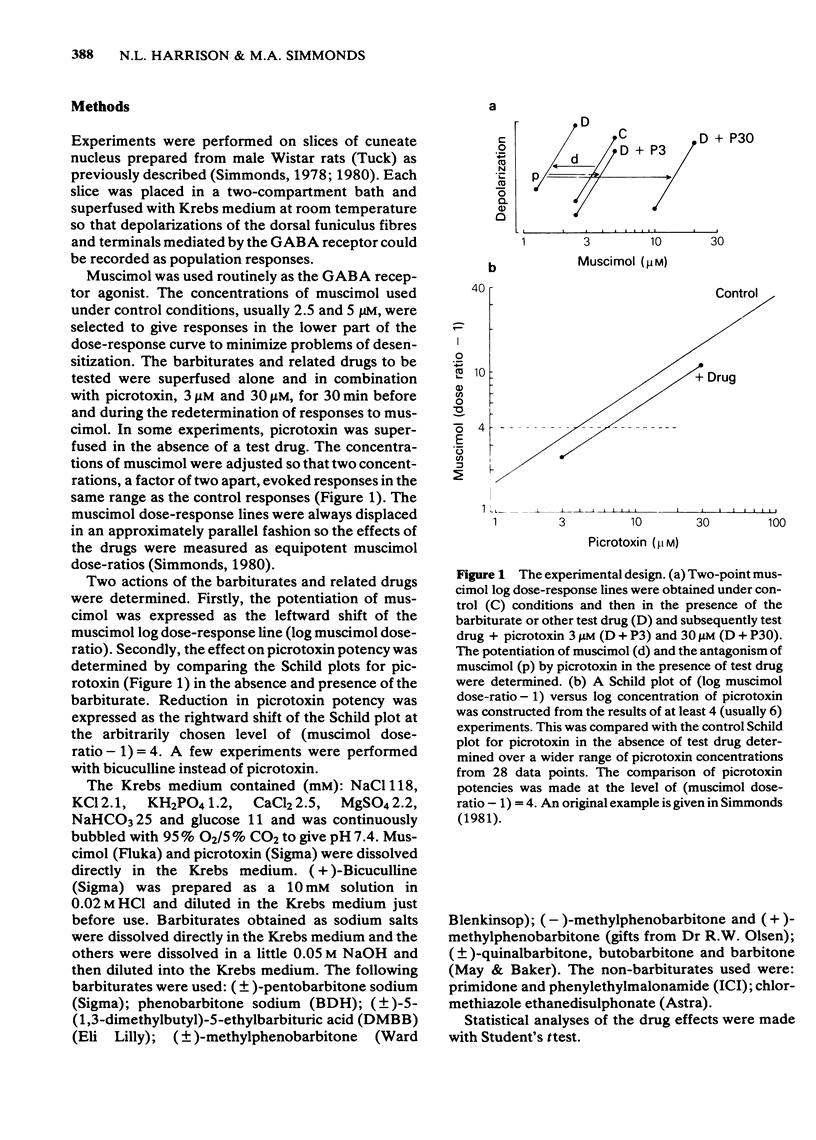
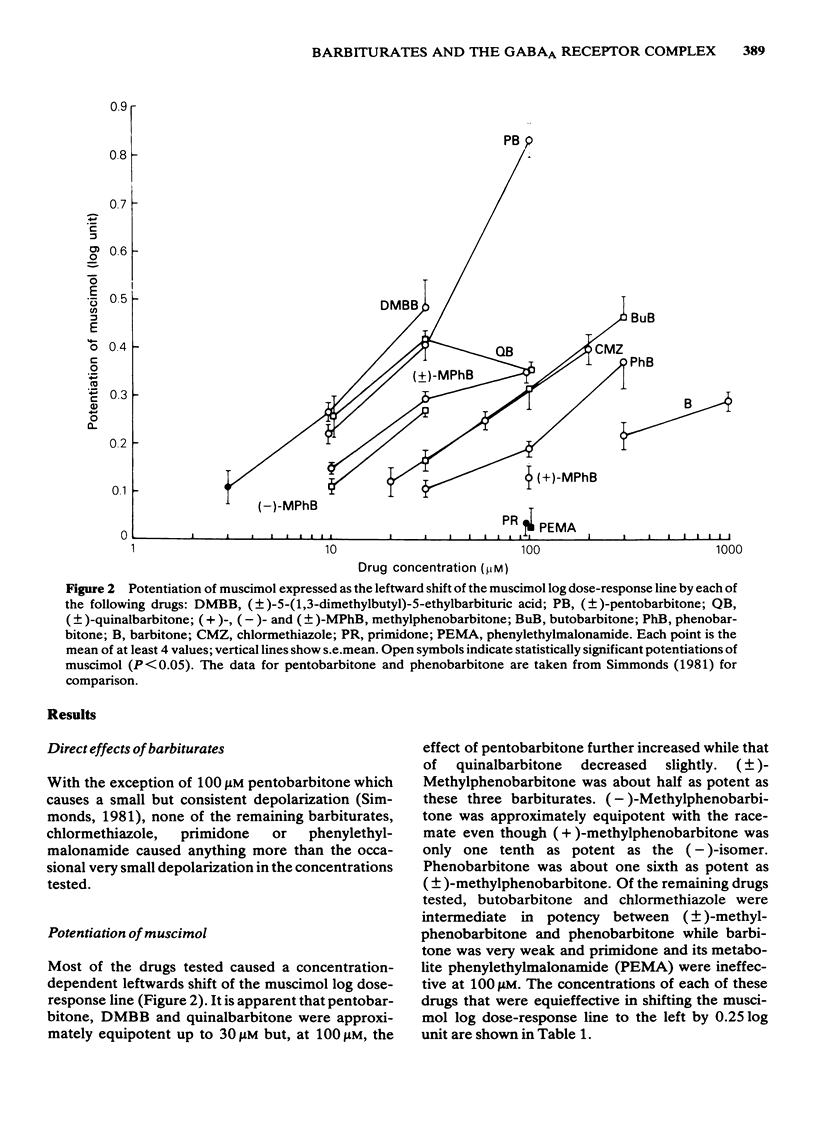
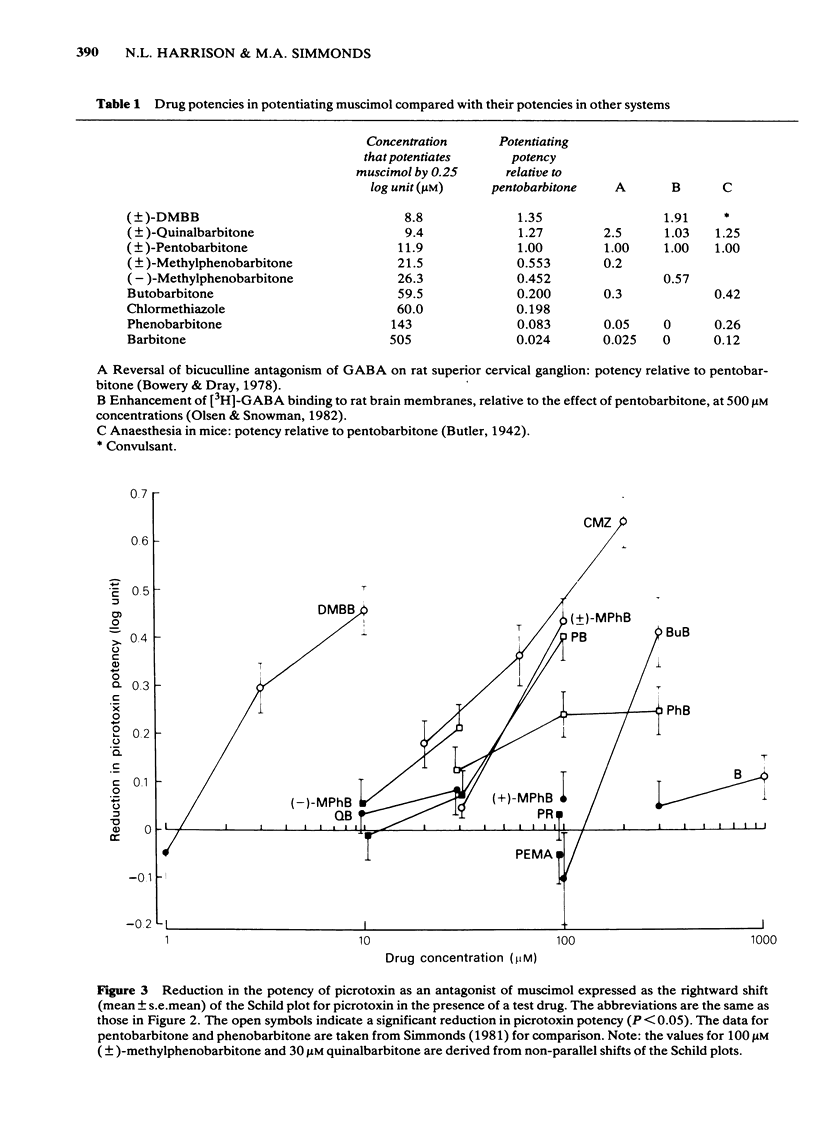
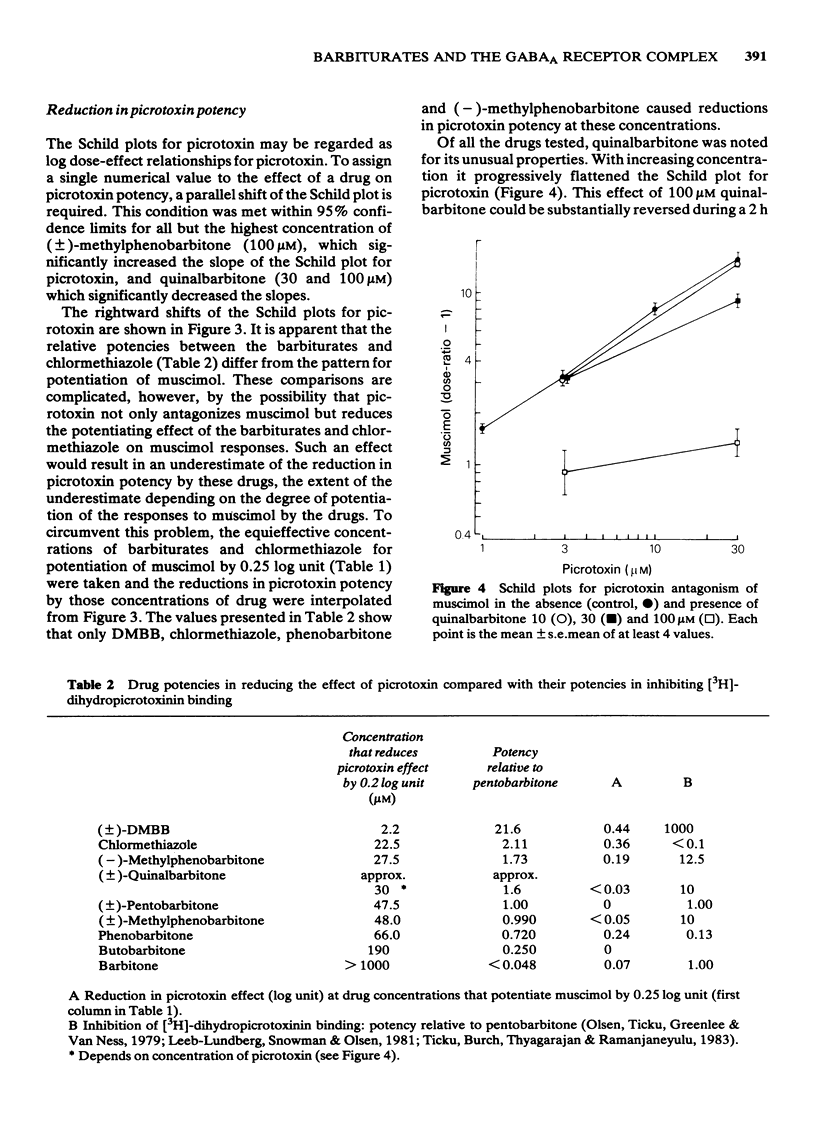
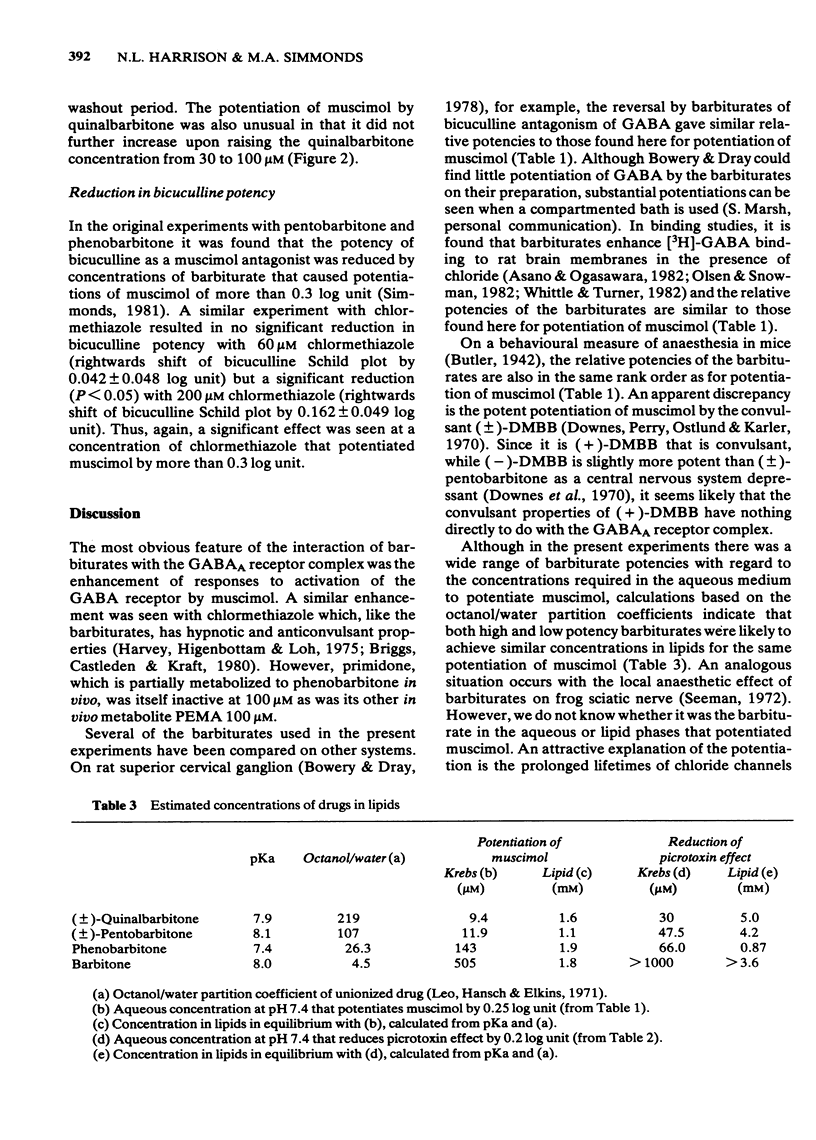
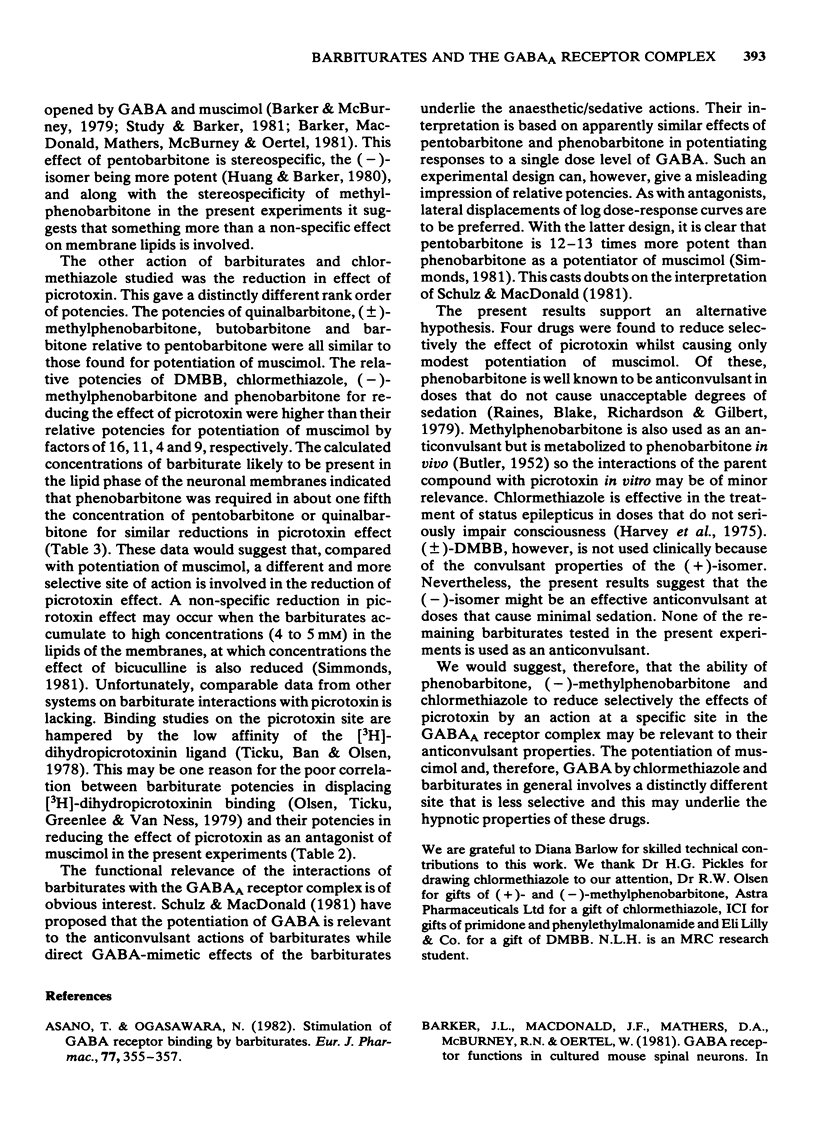
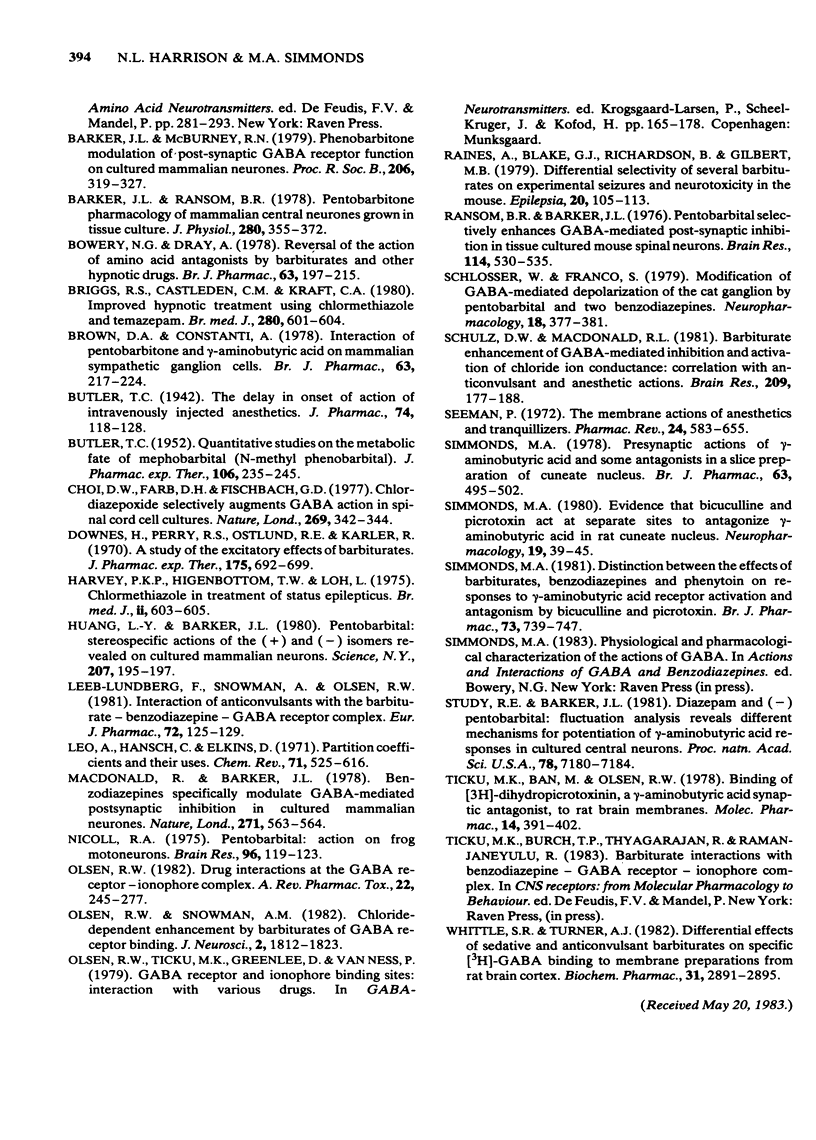
Selected References
These references are in PubMed. This may not be the complete list of references from this article.
- Asano T., Ogasawara N. Stimulation of GABA receptor binding by barbiturates. Eur J Pharmacol. 1982 Feb 5;77(4):355–357. doi: 10.1016/0014-2999(82)90144-3. [DOI] [PubMed] [Google Scholar]
- BUTLER T. C. Quantitative studies of the metabolic fate of mephobarbital (N-methyl phenobarbital). J Pharmacol Exp Ther. 1952 Oct;106(2):235–245. [PubMed] [Google Scholar]
- Barker J. L., McBurney R. N. Phenobarbitone modulation of postsynaptic GABA receptor function on cultured mammalian neurons. Proc R Soc Lond B Biol Sci. 1979 Dec 31;206(1164):319–327. doi: 10.1098/rspb.1979.0108. [DOI] [PubMed] [Google Scholar]
- Barker J. L., Ransom B. R. Pentobarbitone pharmacology of mammalian central neurones grown in tissue culture. J Physiol. 1978 Jul;280:355–372. doi: 10.1113/jphysiol.1978.sp012388. [DOI] [PMC free article] [PubMed] [Google Scholar]
- Bowery N. G., Dray A. Reversal of the action of amino acid antagonists by barbiturates and other hypnotic drugs. Br J Pharmacol. 1978 May;63(1):197–215. doi: 10.1111/j.1476-5381.1978.tb07790.x. [DOI] [PMC free article] [PubMed] [Google Scholar]
- Briggs R. S., Castleden C. M., Kraft C. A. Improved hypnotic treatment using chlormethiazole and temazepam. Br Med J. 1980 Mar 1;280(6214):601–604. doi: 10.1136/bmj.280.6214.601. [DOI] [PMC free article] [PubMed] [Google Scholar]
- Brown D. A., Constanti A. Interaction of pentobarbitone and gamma-aminobutyric acid on mammalian sympathetic ganglion cells. Br J Pharmacol. 1978 May;63(1):217–224. doi: 10.1111/j.1476-5381.1978.tb07791.x. [DOI] [PMC free article] [PubMed] [Google Scholar]
- Choi D. W., Farb D. H., Fischbach G. D. Chlordiazepoxide selectively augments GABA action in spinal cord cell cultures. Nature. 1977 Sep 22;269(5626):342–344. doi: 10.1038/269342a0. [DOI] [PubMed] [Google Scholar]
- Downes H., Perry R. S., Ostlund R. E., Karler R. A study of the excitatory effects of barbiturates. J Pharmacol Exp Ther. 1970 Dec;175(3):692–699. [PubMed] [Google Scholar]
- Harvey P. K., Higenbottam T. W., Loh L. Chlormethiazole in treatment of status epilepticus. Br Med J. 1975 Jun 14;2(5971):603–605. doi: 10.1136/bmj.2.5971.603. [DOI] [PMC free article] [PubMed] [Google Scholar]
- Huang L. Y., Barker J. L. Pentobarbital: stereospecific actions of (+) and (-) isomers revealed on cultured mammalian neurons. Science. 1980 Jan 11;207(4427):195–197. doi: 10.1126/science.7350656. [DOI] [PubMed] [Google Scholar]
- Leeb-Lundberg F., Snowman A., Olsen R. W. Interaction of anticonvulsants with the barbiturate-benzodiazepine-GABA receptor complex. Eur J Pharmacol. 1981 Jun 10;72(1):125–129. doi: 10.1016/0014-2999(81)90309-5. [DOI] [PubMed] [Google Scholar]
- Macdonald R., Barker J. L. Benzodiazepines specifically modulate GABA-mediated postsynaptic inhibition in cultured mammalian neurones. Nature. 1978 Feb 9;271(5645):563–564. doi: 10.1038/271563a0. [DOI] [PubMed] [Google Scholar]
- Nicoll R. A. Pentobarbital: action on frog motoneurons. Brain Res. 1975 Oct 10;96(1):119–123. doi: 10.1016/0006-8993(75)90582-x. [DOI] [PubMed] [Google Scholar]
- Olsen R. W. Drug interactions at the GABA receptor-ionophore complex. Annu Rev Pharmacol Toxicol. 1982;22:245–277. doi: 10.1146/annurev.pa.22.040182.001333. [DOI] [PubMed] [Google Scholar]
- Olsen R. W., Snowman A. M. Chloride-dependent enhancement by barbiturates of gamma-aminobutyric acid receptor binding. J Neurosci. 1982 Dec;2(12):1812–1823. doi: 10.1523/JNEUROSCI.02-12-01812.1982. [DOI] [PMC free article] [PubMed] [Google Scholar]
- Raines A., Blake G. J., Richardson B., Gilbert M. B. Differential selectivity of several barbiturates on experimental seizures and neurotoxicity in the mouse. Epilepsia. 1979 Apr;20(2):105–113. doi: 10.1111/j.1528-1157.1979.tb04783.x. [DOI] [PubMed] [Google Scholar]
- Ransom B. R., Barker J. L. Pentobarbital selectively enhances GABA-mediated post-synaptic inhibition in tissue cultured mouse spinal neurons. Brain Res. 1976 Sep 24;114(3):530–535. doi: 10.1016/0006-8993(76)90977-x. [DOI] [PubMed] [Google Scholar]
- Schlosser W., Franco S. Modification of GABA-mediated depolarization of the cat ganglion by pentobarbital and two benzodiazepines. Neuropharmacology. 1979 Apr;18(4):377–381. doi: 10.1016/0028-3908(79)90145-x. [DOI] [PubMed] [Google Scholar]
- Schulz D. W., Macdonald R. L. Barbiturate enhancement of GABA-mediated inhibition and activation of chloride ion conductance: correlation with anticonvulsant and anesthetic actions. Brain Res. 1981 Mar 23;209(1):177–188. doi: 10.1016/0006-8993(81)91179-3. [DOI] [PubMed] [Google Scholar]
- Seeman P. The membrane actions of anesthetics and tranquilizers. Pharmacol Rev. 1972 Dec;24(4):583–655. [PubMed] [Google Scholar]
- Simmonds M. A. Distinction between the effects of barbiturates, benzodiazepines and phenytoin on responses to gamma-aminobutyric acid receptor activation and antagonism by bicuculline and picrotoxin. Br J Pharmacol. 1981 Jul;73(3):739–747. doi: 10.1111/j.1476-5381.1981.tb16810.x. [DOI] [PMC free article] [PubMed] [Google Scholar]
- Simmonds M. A. Evidence that bicuculline and picrotoxin act at separate sites to antagonize gamma-aminobutyric acid in rat cuneate nucleus. Neuropharmacology. 1980 Jan;19(1):39–45. doi: 10.1016/0028-3908(80)90164-1. [DOI] [PubMed] [Google Scholar]
- Simmonds M. A. Presynaptic actions of gamma-aminobutyric acid and some antagonists in a slice preparation of cuneate nucleus. Br J Pharmacol. 1978 Jul;63(3):495–502. doi: 10.1111/j.1476-5381.1978.tb07803.x. [DOI] [PMC free article] [PubMed] [Google Scholar]
- Study R. E., Barker J. L. Diazepam and (--)-pentobarbital: fluctuation analysis reveals different mechanisms for potentiation of gamma-aminobutyric acid responses in cultured central neurons. Proc Natl Acad Sci U S A. 1981 Nov;78(11):7180–7184. doi: 10.1073/pnas.78.11.7180. [DOI] [PMC free article] [PubMed] [Google Scholar]
- Ticku M. K., Ban M., Olsen R. W. Binding of [3H]alpha-dihydropicrotoxinin, a gamma-aminobutyric acid synaptic antagonist, to rat brain membranes. Mol Pharmacol. 1978 May;14(3):391–402. [PubMed] [Google Scholar]
- Whittle S. R., Turner A. J. Differential effects of sedative and anticonvulsant barbiturates on specific [3H]GABA binding to membrane preparations from rat brain cortex. Biochem Pharmacol. 1982 Sep 15;31(18):2891–2895. doi: 10.1016/0006-2952(82)90260-x. [DOI] [PubMed] [Google Scholar]


